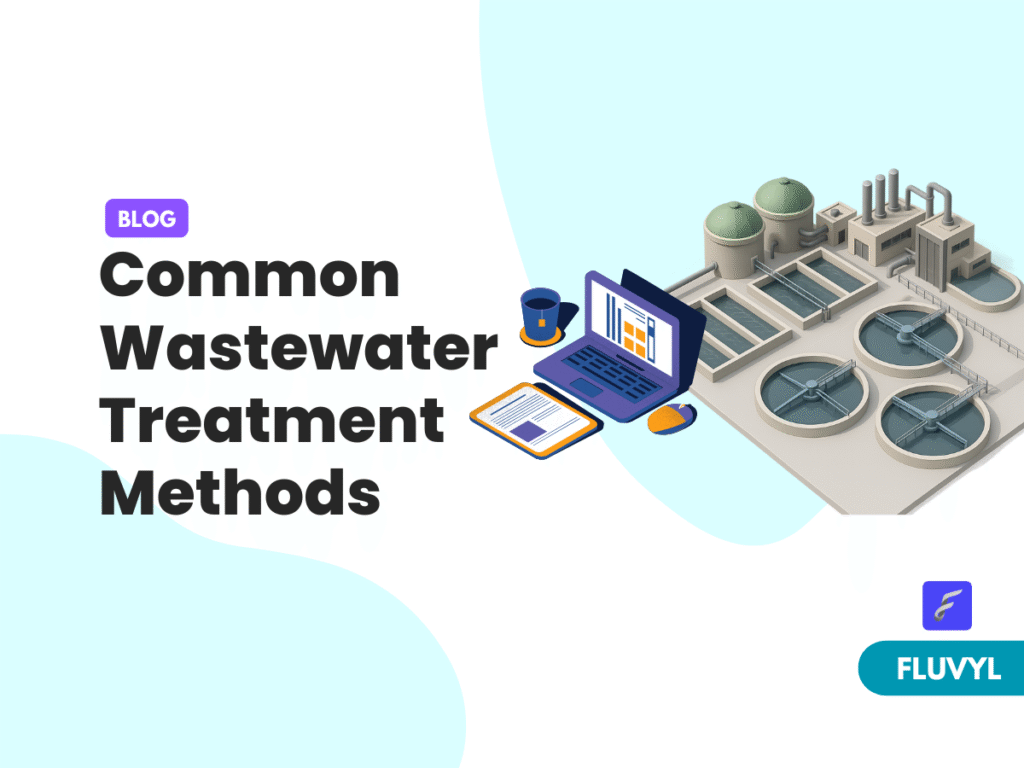Common Wastewater Treatment Methods: Which One is Right for Your Business?

By Fluvyl, updated Apr 15, 2025

Wastewater treatment plays a vital role in preserving environmental integrity and promoting sustainable industrial operations. Businesses of all types are increasingly aware of the need for efficient and effective wastewater management practices, as regulatory requirements grow stricter and environmental concerns intensify. While there are numerous treatment methods available, selecting the most suitable one for a business is often challenging, as it depends on the nature of the wastewater, cost constraints, and industry-specific needs.
In this blog, we will explore some of the Common Wastewater Treatment Methods, comparing three of the most widely used techniques: Activated Sludge, Anaerobic Digestion, and Membrane Filtration. Each method has its advantages and limitations, and understanding their differences will help businesses determine which option best suits their needs.
Synopsis
Choosing the Right Wastewater Treatment Method for Your Business
- Activated Sludge is a biological treatment ideal for organic-rich wastewater from industries like food processing and pharmaceuticals; it’s cost-effective and scalable but energy-intensive and maintenance-heavy.
- Anaerobic Digestion suits high-strength wastewater from sectors such as agriculture and food production, offering biogas energy recovery and lower sludge output, though it requires longer treatment time and specialized equipment.
- Membrane Filtration delivers high-quality effluent suitable for reuse in industries like biotech and microelectronics; it’s compact and effective but comes with higher costs and maintenance due to membrane fouling.
- Method Selection Depends on Key Factors like wastewater type, volume, budget, space availability, and industry-specific standards or reuse goals.
- Informed Choices Enable Sustainability by helping businesses balance regulatory compliance, environmental responsibility, and operational efficiency through the right treatment technology.
1. Activated Sludge: A Biological Approach to Wastewater Treatment
Activated Sludge is one of the Common Wastewater Treatment Methods that uses biological treatment processes to remove pollutants. The process typically occurs in a large aeration tank, where wastewater is mixed with a population of active bacteria and oxygen is supplied to support their growth. These microorganisms digest organic waste, forming a sludge that can be removed later.
A. How Activated Sludge Works
The Activated Sludge process begins when wastewater is introduced into an aeration tank. In this tank, oxygen is pumped in, which encourages the growth of bacteria and other microorganisms. As the microorganisms feed on the organic contaminants in the wastewater, they break down the pollutants into simpler compounds like carbon dioxide and water. After a certain period, the wastewater is sent to a settling tank, where the solid sludge (now rich in microorganisms) settles at the bottom. The clean, treated water is then separated and discharged or sent for further treatment.
B. Pros of Activated Sludge
- Effective for Organic Waste: Activated Sludge is particularly efficient at treating organic pollutants, making it ideal for industrial wastewater like food processing, paper mills, and pharmaceuticals, which produce organic waste.
- Scalable: The Activated Sludge method is adaptable to various wastewater volumes, making it suitable for small businesses and large-scale industrial facilities.
- Cost-Effective: It can be an affordable solution for many businesses, especially those with organic waste as the primary concern.
- Proven Technology: This is one of the most well-established and widely used methods for wastewater treatment, providing reliability and a proven track record.
C. Cons of Activated Sludge
- Energy-Intensive: The need to pump oxygen into the aeration tank means that energy consumption can be high, which may be costly for businesses with large wastewater volumes.
- Requires Regular Maintenance: The microorganisms in the system need to be carefully monitored to maintain the right balance for optimal performance. Routine maintenance and monitoring are essential to prevent system failures.
- Sludge Management: Although the sludge generated can be used as fertilizer in some cases, it requires careful management, which can be challenging for certain industries.
D. Best-Suited Industries for Activated Sludge
- Food and Beverage Processing: These industries produce large volumes of organic waste that can be efficiently treated using the Activated Sludge method.
- Pharmaceuticals: These businesses often deal with complex organic compounds that can be degraded biologically.
- Municipal Wastewater Treatment Plants: Activated Sludge is commonly used for municipal wastewater treatment due to its effectiveness and scalability.
2. Anaerobic Digestion: Harnessing the Power of Microbial Breakdown
Anaerobic digestion is another one of the Common Wastewater Treatment Methods that involves the breakdown of organic matter in the absence of oxygen. This process is typically used to treat high-strength wastewater, such as that generated by food production or agricultural industries. The main advantage of anaerobic digestion is its ability to convert organic waste into biogas (primarily methane), which can be captured and used as an energy source.
A. How Anaerobic Digestion Works
In anaerobic digestion, wastewater is introduced into a sealed tank (called a digester), where microorganisms break down organic materials without oxygen. The process produces biogas, which can be collected and used for energy production, while the remaining sludge is often referred to as digestate. After the digestion process is complete, the treated water and digestate are separated, and the treated water is discharged or further processed.
B. Pros of Anaerobic Digestion
- Energy Recovery: One of the major benefits of anaerobic digestion is the production of biogas, which can be used as a renewable energy source, reducing energy costs and environmental impact.
- Reduced Sludge Production: Compared to other methods, anaerobic digestion produces less sludge, which means lower disposal costs for businesses.
- Low Energy Requirement: Anaerobic digestion requires little energy compared to methods like Activated Sludge, making it a more energy-efficient option for wastewater treatment.
- Sustainable and Eco-Friendly: By producing biogas, anaerobic digestion contributes to sustainability and helps reduce greenhouse gas emissions.
C. Cons of Anaerobic Digestion
- Longer Treatment Time: The anaerobic digestion process typically takes longer than aerobic methods like Activated Sludge, which may not be ideal for businesses needing quick results.
- Requires Specialized Equipment: Anaerobic digestion systems require specialized equipment, which can be expensive to install and maintain.
- Not Suitable for Low-Strength Wastewater: This method is better suited for high-strength wastewater with significant organic content. It is less effective for treating wastewater with a low organic load.
D. Best-Suited Industries for Anaerobic Digestion
- Food Processing: This method is ideal for businesses that produce organic waste, such as dairy, meat processing, and breweries.
- Agriculture and Livestock Farming: Anaerobic digestion is effective for managing wastewater from farms, including manure and agricultural runoff.
- Energy and Waste-to-Energy Facilities: Anaerobic digestion is commonly used in biogas plants to generate renewable energy from organic waste.
3. Membrane Filtration: Advanced Physical Treatment
Membrane filtration is a Common Wastewater Treatment Method that uses semi-permeable membranes to remove contaminants from wastewater. This technology is particularly effective for removing suspended solids, bacteria, and other microorganisms from water, producing high-quality effluent that is suitable for reuse or discharge into the environment. Membrane filtration is a versatile solution and can be used in conjunction with other treatment methods.
How Membrane Filtration Works
The pressure difference across the membrane drives the filtration process, and the filtered water (permeate) is collected, while the retained particles (concentrate) are discarded. Different types of membrane filtration include microfiltration (MF), ultrafiltration (UF), nanofiltration (NF), and reverse osmosis (RO), each with varying pore sizes and capabilities.
Pros of Membrane Filtration
- High-Quality Effluent: Membrane filtration provides high-quality treated water, making it ideal for industries that require water reuse or discharge meeting strict regulatory standards.
- Compact and Space-Efficient: Membrane filtration systems are typically more compact than other treatment methods, making them a good fit for businesses with limited space.
- Low Chemical Usage: Unlike chemical treatments, membrane filtration primarily relies on physical separation, reducing the need for chemicals and lowering potential environmental impacts.
- Versatility: Membrane filtration can be used in a variety of industries and is effective for removing a wide range of contaminants, including microorganisms, suspended solids, and certain dissolved substances.
Cons of Membrane Filtration
- High Operating Costs: Membrane filtration systems can have high operating costs due to the need for regular membrane cleaning and replacement, as well as energy consumption.
- Fouling Issues: Over time, membranes can become fouled by the contaminants in wastewater, reducing their effectiveness and requiring maintenance and cleaning.
- Initial Investment: The capital investment for membrane filtration systems can be significant, which may make it less attractive for small businesses.
Best-Suited Industries for Membrane Filtration
- Pharmaceuticals and Biotech: These industries require highly purified water and can benefit from the high-quality effluent produced by membrane filtration.
- Microelectronics: Semiconductor manufacturing and other high-tech industries often use membrane filtration to treat wastewater and meet stringent water purity requirements.
- Textile Industry: The textile industry generates wastewater that contains dyes and chemicals, which membrane filtration can effectively remove.
Conclusion: Choosing the Right Wastewater Treatment Method for Your Business
Selecting the most appropriate wastewater treatment method for your business is a crucial decision that depends on factors such as the type and volume of wastewater, cost constraints, and environmental goals. Here’s a quick recap of the Common Wastewater Treatment Methods:
- Activated Sludge is best for businesses dealing with organic waste, such as food processing and pharmaceuticals. It is cost-effective but requires significant energy input and regular maintenance.
- Anaerobic Digestion is ideal for high-strength wastewater, such as that produced by food processing or agriculture. It offers energy recovery through biogas and produces less sludge but has longer treatment times.
- Membrane Filtration is suited for industries that require high-quality treated water for reuse or discharge, such as pharmaceuticals, biotech, and textiles. While it offers excellent water quality, it has higher operational costs.
By understanding the pros and cons of these methods, businesses can choose the right solution that balances environmental impact, operational costs, and regulatory compliance. With the right wastewater treatment method, companies can contribute to a cleaner environment, lower operational costs, and sustainable business practices.
